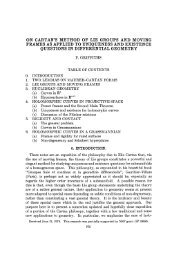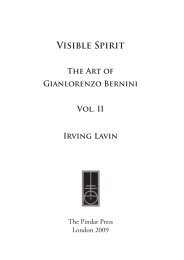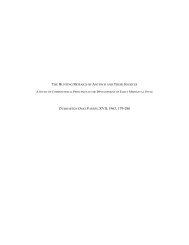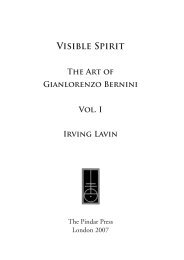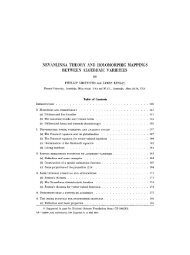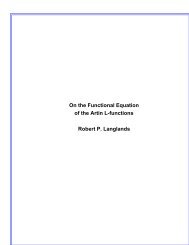View PDF - Project Euclid
View PDF - Project Euclid
View PDF - Project Euclid
Create successful ePaper yourself
Turn your PDF publications into a flip-book with our unique Google optimized e-Paper software.
CURVATURE AND COMPLEX SINGULARITIES 511<br />
formula (5.30) can be established for a general 1-parameter family of metrics<br />
which need not come from embeddings in IRN. Since any metric can be connected<br />
by a linear homotopy to one coming from such an embedding, we have<br />
thus established (5.29) for any metric. The point is that, just as the expressions<br />
in Weyl’s tube formula turn out to be intrinsic invariants of the induced metric<br />
and therefore have meaning for any Riemannian manifold, the same will be true<br />
for the variation (5.30) of the Gauss-Bonnet integrand.<br />
An interesting question is whether we can use a similar argument to establish<br />
the topological invariance of the top Milnor number/x" + of a hypersurface<br />
V0 c Cn / having an isolated singularity at the origin. This is especially intriguing<br />
since the example of Briancon and Speder (cf. Tessier, loc. cit.) shows<br />
that the lower Milnor numbers may not be topologically invariant. Suppose<br />
then that {Vt,s} is a family of complex-analytic hypersurfaces parametrized by<br />
h I where A is the disc {Itl < 1} and I is the real interval {0 _< --- s 1}, and<br />
where Vt,s is smooth for 0 while V0, has an isolated singularity at the origin.<br />
We assume that, for fixed s, the V,s fill out a neighborhood U of the origin, and<br />
setting U* U- {0} define<br />
3/: U* I (E" +1 X G(n, n + 1)<br />
by y(z, s) (z, Tz(Vt,s)) where z Vt,s (t #-0). For any invariant curvature<br />
polynomial Pk(IlE) on G(n, N) we set<br />
on U* x I, so that<br />
y*(b n-k A P(OE)) A ds<br />
dp Vt,s 49"- /k P()vt,)"<br />
Since this form is closed, as in (5.30) we deduce that<br />
0<br />
s dT<br />
so that for # 0<br />
(5.31)<br />
0<br />
( )Iv<br />
pk(.Vt,s)/n_k=<br />
t,s[ OV ,s[ e]<br />
Observe that the right hand side of (5.31) is defined also for O.<br />
If we now let be the form arising from c(O), then (5.23) together with<br />
the topological invariance of the Milnor numbers suggests that<br />
2(n k)<br />
k 0 V0,s[e]<br />
On the other hand, since the lower Milnor numbers are not topologically invariant,<br />
we will not have<br />
(5.33) lim<br />
ez(,<br />
O.





